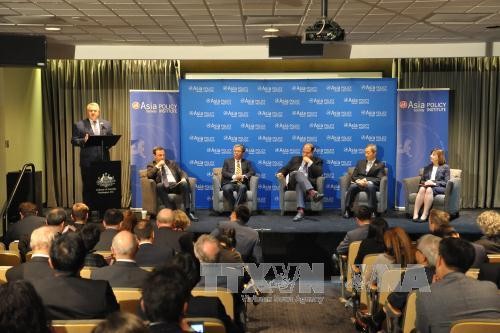(VOVworld) – The US-based Asia Society Policy Institute recently released a report entitled “Charting a course for trade and economic integration in the Asia-Pacific.” Amid challenges facing global trade, the report spotlighted a need for closer regional integration.
 |
The launch ceremony of the report “Charting a course for trade and economic integration in the Asia-Pacific.” (Photo: Thanh Tuan/VNA correspondent in the US)
|
As global growth slows, widespread skepticism about trade liberalization and globalization evidenced by the UK leaving the EU and the US withdrawing from the Trans-Pacific Partnership (TPP) is putting Asia-Pacific trade policy at a critical crossroad.
New course for regional integration
In the face of global uncertainty, the Asia-Pacific region, which represents nearly 60% of global GDP and 50% of global trade, must find a new direction.
The report written by senior trade experts recommend promoting high standards and inclusiveness in trade agreements, increasing regional economic integration, building support for trade agreements by better communicating their benefits, and working with multilateral forums. It also proposes higher standards for the Regional Comprehensive Economic Partnership (RCEP) negotiations and pursuit of regional trade liberalization opportunities through bilateral and multilateral efforts.
At the Asia-Pacific Economic Cooperation (APEC) forum in Peru late last year, leaders renewed their commitment to trade liberalization. Despite concerns about the US new administration’s policies, leaders of the 21 APEC economies said the US withdrawal from TPP would not affect their goal of free trade.
Other options
Many countries are seeking a TPP replacement. A Regional Comprehensive Economic Partnership comprising of 10 ASEAN members plus China, Japan, New Zealand, and Australia is the likely choice. RCEP negotiations are underway and should be completed by the middle of this year. If the TPP emphasizes business conditions, standards, regulations and intellectual property rights, RCEP focuses on tax cuts and service liberalization. Observers say this doesn’t mean that RCEP is less ambitious than TPP, but it has no discrimination standards of developed countries as conditions for membership. RCEP aims to open markets to all goods by making trade easier and encouraging cooperation.
China, which was excluded from TPP membership, is seizing the opportunity to redraw the Asian trade picture by pushing its own trade deals. Beijing is promoting the Free Trade Area of the Asia-Pacific (FTAAP), whose members include all 21 APEC economies.
But economists say the US’s new attitude of protectionism will hinder global trade and investment. The Asia-Pacific should continue to work to build a prosperous and dynamic regional community. APEC, with 140 free trade agreements between members and trade facilitation projects like RCEP, remains a key framework for trade promotion despite troubling global uncertainties.